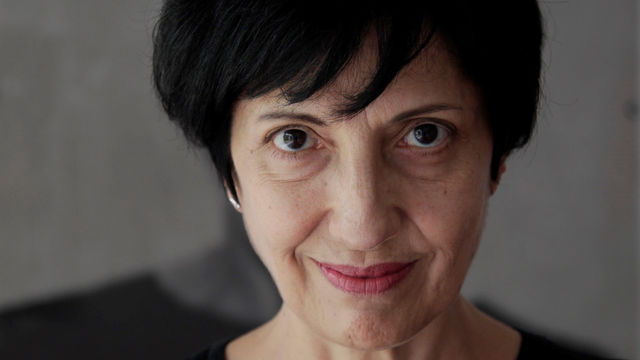
Lenora de Barros
Lenora de Barros was born in 1953 in São Paulo, where she continues to live and work. Influenced by the work of her father, the artist Geraldo de Barros (1923–1998), and his peers, Lenora de Barros took an early interest in concretism. In 1970 she graduated with a bachelor's degree in linguistics from the School of Philosophy, Universidad de São Paulo, and immediately began considering the intersections between her already developed poetry practice and visual art. In 1975, together with Augusto de Campos, Haroldo de Campos, Julio Plaza, and Regina Silveira, she edited the magazine of experimental art and visual poetry Poesia em greve. In 1979 she developed one of her first visual poems, Poema, a series of photographs depicting the artist's tongue interacting with the mechanism of a typewriter. She spent much of the 1980s writing poems, publishing her first book, Onde se vê (Where it's seen) in 1983. Also in 1983 she presented visual poems at the 17th Bienal de São Paulo in a section titled "Arte em videotexto." From 1986 to 1989 de Barros worked at the Brazilian newspaper Folha de S.Paulo, initially as an editorial assistant and then as an art editor.
In 1990 she moved with her husband to Milan, where, despite staying only two years, her encounter with experimental Italian artists rekindled her interest in the space of words and her own visual art production. In Milan she held her first solo exhibition, Poesia é coisa de nade (1990), consisting of five thousand Ping-Pong balls covering the gallery floor, each inscribed with the title of the exhibition. The balls, or "ping-poems" as de Barros later named them, would become a staple of the artist's practice, reappearing during the next two decades in her installations and performances. In 1994 she began putting the bouncing balls in motion so that their sound became part of the piece. Between 1993 and 1996 the artist wrote a weekly column she called Umas (Some) for the São Paulo newspaper Journal da Tarde. De Barros used the publication for experimentation and dialogue with other artists, presenting photo performances and visual poems that explored the relationship between image and text. De Barros has said that the column served as her personal laboratory, as many of the columns were later developed into artworks.
While text always remained central to her work, de Barros's practice expanded to live, video-recorded, or photographed performance. Still actively creating work today, de Barros incorporates tenets of pop art, Fluxus, conceptual art, and body art to explore visual and verbal communication. She has received several awards, including the Bolsa da Fundação Vitae (2002) and Prêmio multicultural do jornal O Estado de São Paulo (2000). Her work is included in collections such as the Museu d'Art Contemporani de Barcelona, Museu de Arte Moderna de São Paulo, Centro Cultural São Paulo, and Daros Latinamerica Collection in Zurich.
—Courtney Smith
Selected Solo Exhibitions
2002 Procuro-me, Centro Cultural Sérgio Porto, Rio de Janeiro (traveled)
2003 Ping-poems, Galeria da Fundação do Centro de Estudos Brasileiros, Buenos Aires
2010 Revídeo: Lenora de Barros, Oi Futuro, Rio de Janeiro
2011 Lenora de Barros: De stempos, Laura Marsiaj Arte Contemporânea, Rio de Janeiro
2013–14 Umas e outras, Casa de Cultura Laura Alvim, Rio de Janeiro (traveled)
Selected Bibliography
Bandeira, João, and Lenora de Barros. Grupo Noigandres. São Paulo: Cosac & Naify, 2002
de Barros, Lenora. Onde se vê. São Paulo: Klaxon, 1983.
de Barros, Lenora, and Luiza Mello, eds. Relivro Lenora de Barros. Rio de Janeiro: Automática and Oi Futuro, 2011.
Lenora de Barros: Umas e outras. Rio de Janeiro: Galeria Laura Alvim, 2013.
Souza Xavier, Eduardo de. Coisa em si: Conversas com Lenora de Barros. Porto Alegre, Brazil: Zouk, 2011.


